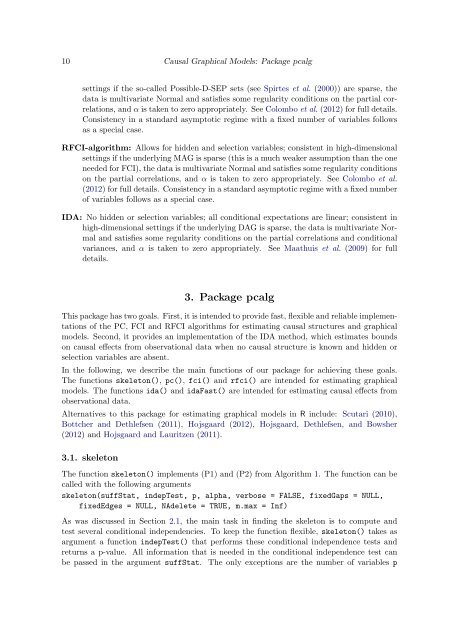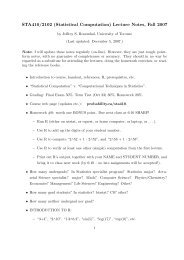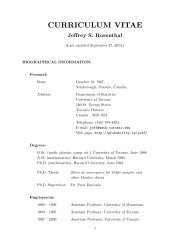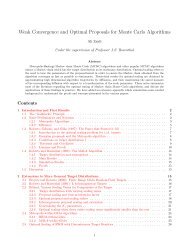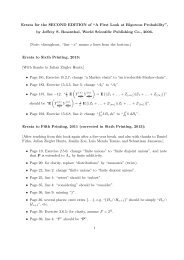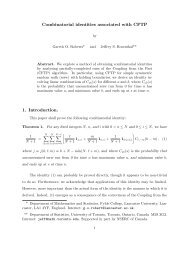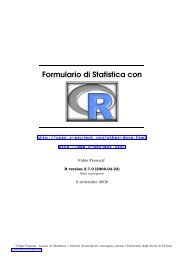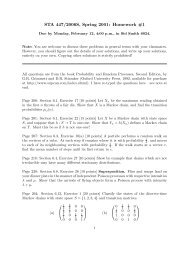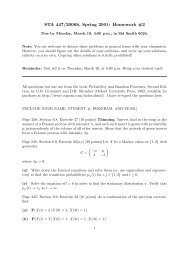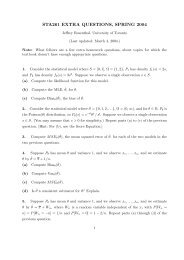Causal Inference: The R package pcalg
Causal Inference: The R package pcalg
Causal Inference: The R package pcalg
Create successful ePaper yourself
Turn your PDF publications into a flip-book with our unique Google optimized e-Paper software.
10 <strong>Causal</strong> Graphical Models: Package <strong>pcalg</strong><br />
settings if the so-called Possible-D-SEP sets (see Spirtes et al. (2000)) are sparse, the<br />
data is multivariate Normal and satisfies some regularity conditions on the partial correlations,<br />
and α is taken to zero appropriately. See Colombo et al. (2012) for full details.<br />
Consistency in a standard asymptotic regime with a fixed number of variables follows<br />
as a special case.<br />
RFCI-algorithm: Allows for hidden and selection variables; consistent in high-dimensional<br />
settings if the underlying MAG is sparse (this is a much weaker assumption than the one<br />
needed for FCI), the data is multivariate Normal and satisfies some regularity conditions<br />
on the partial correlations, and α is taken to zero appropriately. See Colombo et al.<br />
(2012) for full details. Consistency in a standard asymptotic regime with a fixed number<br />
of variables follows as a special case.<br />
IDA: No hidden or selection variables; all conditional expectations are linear; consistent in<br />
high-dimensional settings if the underlying DAG is sparse, the data is multivariate Normal<br />
and satisfies some regularity conditions on the partial correlations and conditional<br />
variances, and α is taken to zero appropriately. See Maathuis et al. (2009) for full<br />
details.<br />
3. Package <strong>pcalg</strong><br />
This<strong>package</strong>hastwogoals. First, itisintendedtoprovidefast, flexibleandreliableimplementations<br />
of the PC, FCI and RFCI algorithms for estimating causal structures and graphical<br />
models. Second, it provides an implementation of the IDA method, which estimates bounds<br />
on causal effects from observational data when no causal structure is known and hidden or<br />
selection variables are absent.<br />
In the following, we describe the main functions of our <strong>package</strong> for achieving these goals.<br />
<strong>The</strong> functions skeleton(), pc(), fci() and rfci() are intended for estimating graphical<br />
models. <strong>The</strong> functions ida() and idaFast() are intended for estimating causal effects from<br />
observational data.<br />
Alternatives to this <strong>package</strong> for estimating graphical models in R include: Scutari (2010),<br />
Bottcher and Dethlefsen (2011), Hojsgaard (2012), Hojsgaard, Dethlefsen, and Bowsher<br />
(2012) and Hojsgaard and Lauritzen (2011).<br />
3.1. skeleton<br />
<strong>The</strong> function skeleton() implements (P1) and (P2) from Algorithm 1. <strong>The</strong> function can be<br />
called with the following arguments<br />
skeleton(suffStat, indepTest, p, alpha, verbose = FALSE, fixedGaps = NULL,<br />
fixedEdges = NULL, NAdelete = TRUE, m.max = Inf)<br />
As was discussed in Section 2.1, the main task in finding the skeleton is to compute and<br />
test several conditional independencies. To keep the function flexible, skeleton() takes as<br />
argument a function indepTest() that performs these conditional independence tests and<br />
returns a p-value. All information that is needed in the conditional independence test can<br />
be passed in the argument suffStat. <strong>The</strong> only exceptions are the number of variables p


